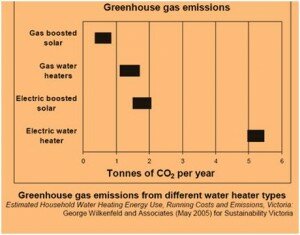Which Solar Hot Water Heating System?
Friday, May 8th, 2009(Part One)
One of the most energy intensive (and therefore costly) processes in any house is the heating of water. Heating water accounts to about 37% – 40% of the annual energy consumption in an average Australian household and about 20% of its greenhouse emissions. Therefore it is important to consider all the alternatives, such as using the heat of the sun in solar hot water systems.
The diagram below summarises the GHG emissions of each type of hot water system.
Throughout the day, a sensor monitors the difference in water temperature between the water in the storage tank and the water in the collector (typically mounted on the roof). At a preset temperature difference, the sensor triggers a pump to circulate the water through the collectors where it absorbs solar heat.
Below is a summary of the two types of commonly used domestic solar hot water systems. Both the flat panel and evacuated systems have several versions, where gas or electricity is used to boost the water temperature if it is not sufficiently hot coming out of the water tank. In most cases the sun is simply used to ‘preheat’ the water to higher temperatures (40-70 C) before it goes into a storage tank. A pump may be used to circulate the water from the tank to the collectors until it is used. In addition the flat panel systems may use a heat-exchange mechanism typically where the water may freeze.
Flat panel or evacuated tubes?
In recent years evacuated tubes have become more popular and affordable and together with the flat panels have become widely used in Australia, especially since generous government rebates have been introduced. However, it is still disputed which system is better than the other. Obviously the manufacturers of each type of system claim that theirs is better than the other (sometimes claiming 90% to 160% more efficiency than the other system). The following reasons have been cited: because it captures sunlight better, is better in certain climates, is more cost effective, has better output for dollar spent, has faster payback, is less prone to failure or damage, is cheaper to repair, requires less roof installation area, etc.
It is difficult to find impartial opinions on the subject. It seems that each system should be examined in its own context. The climatic conditions and application will determine the better collector. One of them may be the preferred choice over the other due to a number of variables, such as the environment, availability of sunlight, elevation, orientation, average outdoor temperature, greenhouse gas savings, ease of installation including existing plumbing, payback period, running cost, availability of natural gas to use for boosting water temperature, how well the hot water tanks are insulated and many other factors. So which one is better and how do they compare?
To be continued……..soon……….



